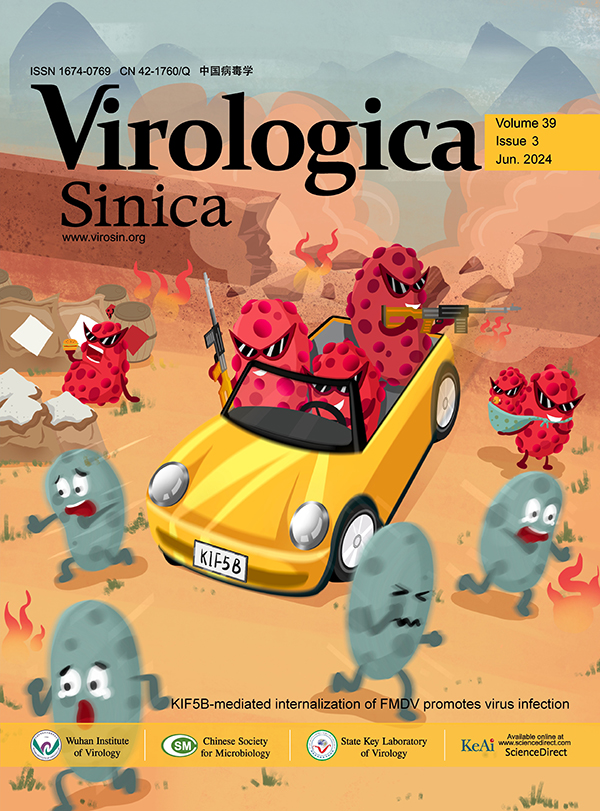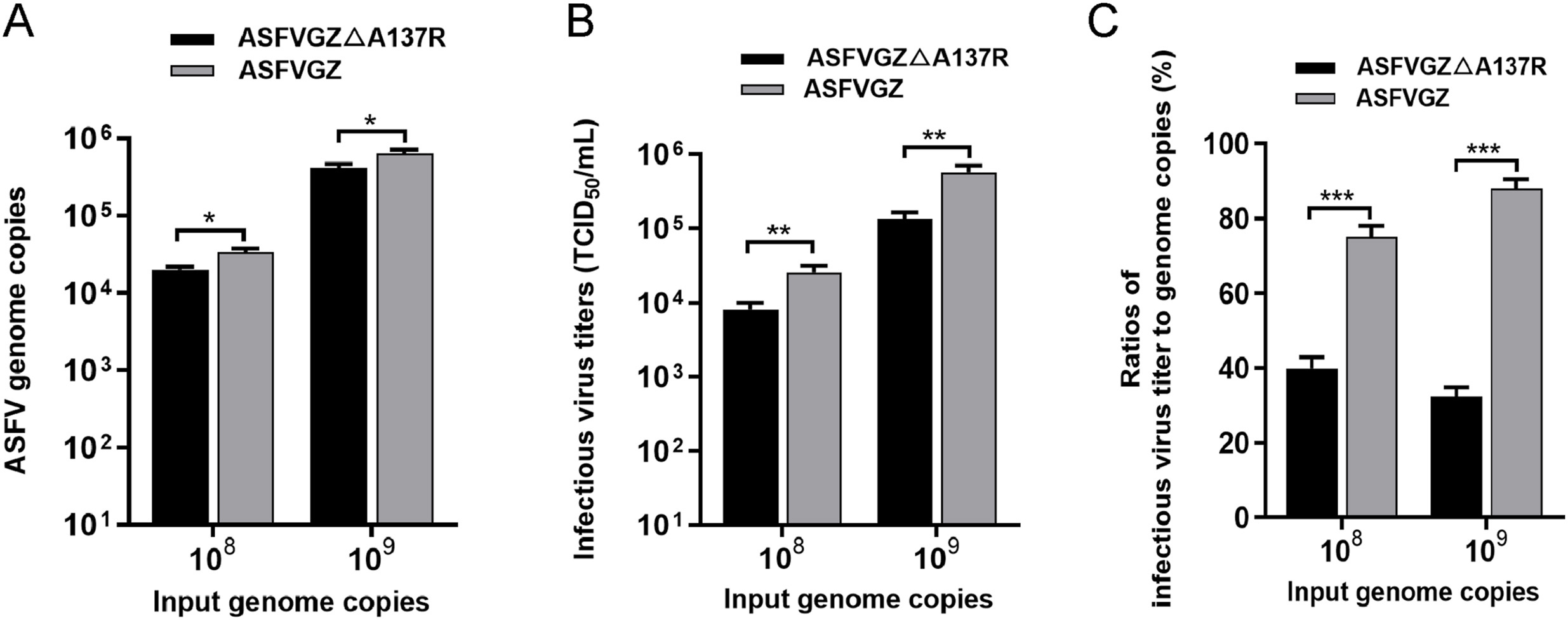-
Alcami, A., Angulo, A.,Vinuela, E., 1993. Mapping and sequence of the gene encoding the African swine fever virion protein of M(r) 11500. J. Gen. Virol., 74 (Pt 11), 2317-2324.
-
Alejo, A., Matamoros, T., Guerra, M.,Andres, G., 2018. A proteomic atlas of the African swine fever virus particle. J. Virol., 92, e01293-18.
-
Andres, G., Charro, D., Matamoros, T., Dillard, R.S., Abrescia, N.G.A., 2020. The cryo-EM structure of African swine fever virus unravels a unique architecture comprising two icosahedral protein capsids and two lipoprotein membranes. J. Biol. Chem., 295, 1-12.
-
Andres, G., Garcia-Escudero, R., Vinuela, E., Salas, M.L.,Rodriguez, J.M., 2001. African swine fever virus structural protein pE120R is essential for virus transport from assembly sites to plasma membrane but not for infectivity. J. Virol., 75, 6758-6768.
-
Borca, M.V., Ramirez-Medina, E., Silva, E., Vuono, E., Rai, A., Pruitt, S., Holinka, L.G., Velazquez-Salinas, L., Zhu, J.,Gladue, D.P., 2020. Development of a highly effective African swine fever virus vaccine by deletion of the I177L gene results in sterile immunity against the current epidemic Eurasia strain. J. Virol., 94, e02017-19.
-
Cackett, G., Matelska, D., Sykora, M., Portugal, R., Malecki, M., Bahler, J., Dixon, L., Werner, F., 2020. The African swine fever virus transcriptome. J. Virol., 94, e00119-20.
-
Dixon, L.K., Chapman, D.A., Netherton, C.L., Upton, C., 2013. African swine fever virus replication and genomics. Virus Res., 173, 3-14.
-
Dixon, L.K., Sun, H.,Roberts, H., 2019. African swine fever. Antivir. Res., 165, 34-41.
-
Epifano, C., Krijnse-Locker, J., Salas, M.L., Rodriguez, J.M.,Salas, J., 2006. The African swine fever virus nonstructural protein pB602L is required for formation of the icosahedral capsid of the virus particle. J. Virol., 80, 12260-12270.
-
Galindo, I.,Alonso, C., 2017. African swine fever virus: a review. Viruses, 9, 103.
-
Gaudreault, N.N., Madden, D.W., Wilson, W.C., Trujillo, J.D., Richt, J.A., 2020. African swine fever virus: an emerging DNA arbovirus. Front. Vet. Sci., 7, 215.
-
Gladue, D.P., Ramirez-Medina, E., Vuono, E., Silva, E., Rai, A., Pruitt, S., Espinoza, N., Velazquez-Salinas, L.,Borca, M.V., 2021. Deletion of the A137R gene from the pandemic strain of African swine fever virus attenuates the strain and offers protection against the virulent pandemic virus. J. Virol., 95, e0113921.
-
Huang, J., Liu, T., Li, K., Song, X., Yan, R., Xu, L.,Li, X., 2018. Proteomic analysis of protein interactions between Eimeria maxima sporozoites and chicken jejunal epithelial cells by shotgun LC-MS/MS. Parasites Vectors, 11, 226.
-
Jia, N., Ou, Y., Pejsak, Z., Zhang, Y.,Zhang, J., 2017. Roles of African swine fever virus structural proteins in viral infection. J Vet Res, 61, 135-143.
-
Kessler, C., Forth, J.H., Keil, G.M., Mettenleiter, T.C., Blome, S.,Karger, A., 2018. The intracellular proteome of African swine fever virus. Sci. Rep., 8, 14714.
-
King, D.P., Reid, S.M., Hutchings, G.H., Grierson, S.S., Wilkinson, P.J., Dixon, L.K., Bastos, A.D.,Drew, T.W., 2003. Development of a TaqMan PCR assay with internal amplification control for the detection of African swine fever virus. J Virol Methods, 107, 53-61.
-
Kleiboeker, S.B., Kutish, G.F., Neilan, J.G., Lu, Z., Zsak, L.,Rock, D.L., 1998. A conserved African swine fever virus right variable region gene, l11L, is non-essential for growth in vitro and virulence in domestic swine. J. Gen. Virol., 79 (Pt 5), 1189-1195.
-
Liu, Q., Ma, B., Qian, N., Zhang, F., Tan, X., Lei, J.,Xiang, Y., 2019a. Structure of the African swine fever virus major capsid protein p72. Cell Res., 29, 953-955.
-
Liu, S., Luo, Y., Wang, Y., Li, S., Zhao, Z., Bi, Y., Sun, J., Peng, R., Song, H., Zhu, D., Sun, Y., Li, S., Zhang, L., Wang, W., Sun, Y., Qi, J., Yan, J., Shi, Y., Zhang, X., Wang, P., Qiu, H.J.,Gao, G.F., 2019b. Cryo-EM structure of the African swine fever virus. Cell Host Microbe, 26, 836-843.e3.
-
Liu, Y., Li, Y., Xie, Z., Ao, Q., Di, D., Yu, W., Lv, L., Zhong, Q., Song, Y., Liao, X., Song, Q., Wang, H.,Chen, H., 2021. Development and in vivo evaluation of MGF100-1R deletion mutant in an African swine fever virus Chinese strain. Vet. Microbiol., 261, 109208.
-
Liu, Y., Xie, Z., Li, Y., Song, Y., Di, D., Liu, J., Gong, L., Chen, Z., Wu, J., Ye, Z., Liu, J., Yu, W., Lv, L., Zhong, Q., Tian, C., Song, Q., Wang, H.,Chen, H., 2023. Evaluation of an I177L gene-based five-gene-deleted African swine fever virus as a live attenuated vaccine in pigs. Emerg. Microb. Infect., 12, 2148560.
-
Martinez-Pomares, L., Simon-Mateo, C., Lopez-Otin, C.,Vinuela, E., 1997. Characterization of the African swine fever virus structural protein p14.5: a DNA binding protein. Virology, 229, 201-211.
-
Pujols, J., Blazquez, E., Segales, J., Rodriguez, F., Chang, C.Y., Argilaguet, J., Bosch-Camos, L., Rosell, R., Pailler-Garcia, L., Gavrilov, B., Campbell, J.,Polo, J., 2023. Feeding spray-dried porcine plasma to pigs improves the protection afforded by the African swine fever virus (ASFV) BA71ΔCD2 vaccine prototype against experimental challenge with the pandemic ASFV-Study 2. Vaccines (Basel), 11, 825.
-
Revilla, Y., Perez-Nunez, D.,Richt, J.A., 2018. African swine fever virus biology and vaccine approaches. Adv. Virus Res., 100, 41-74.
-
Salas, M.L.,Andres, G., 2013. African swine fever virus morphogenesis. Virus Res., 173, 29-41.
-
Sun, M., Yu, S., Ge, H., Wang, T., Li, Y., Zhou, P., Pan, L., Han, Y., Yang, Y., Sun, Y., Li, S., Li, L.F.,Qiu, H.J., 2022. The A137R protein of African swine fever virus inhibits type I interferon production via the autophagy-mediated lysosomal degradation of TBK1. J. Virol., 96, e0195721.
-
Wang, N., Zhao, D., Wang, J., Zhang, Y., Wang, M., Gao, Y., Li, F., Wang, J., Bu, Z., Rao, Z.,Wang, X., 2019. Architecture of African swine fever virus and implications for viral assembly. Science, 366, 640-644.
-
Yang, S., Miao, C., Liu, W., Zhang, G., Shao, J.,Chang, H., 2023. Structure and function of African swine fever virus proteins: current understanding. Front. Microbiol., 14, 1043129.
-
Yin, D., Geng, R., Shao, H., Ye, J., Qian, K., Chen, H.,Qin, A., 2022. Identification of novel linear epitopes in P72 protein of African swine fever virus recognized by monoclonal antibodies. Front. Microbiol., 13, 1055820.
-
Zhou, P., Li, L.F., Zhang, K., Wang, B., Tang, L., Li, M., Wang, T., Sun, Y., Li, S.,Qiu, H.J., 2022. Deletion of the H240R gene of African swine fever virus decreases infectious progeny virus production due to aberrant virion morphogenesis and enhances inflammatory cytokine expression in porcine macrophages. J. Virol., 96, e0166721.
-
Zsak, L., Lu, Z., Kutish, G.F., Neilan, J.G.,Rock, D.L., 1996. An African swine fever virus virulence-associated gene NL-S with similarity to the herpes simplex virus ICP34.5 gene. J. Virol., 70, 8865-8871.














 DownLoad:
DownLoad: